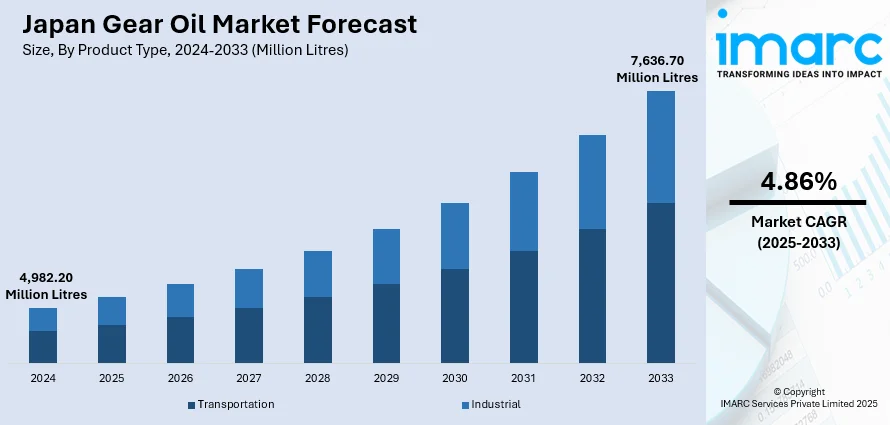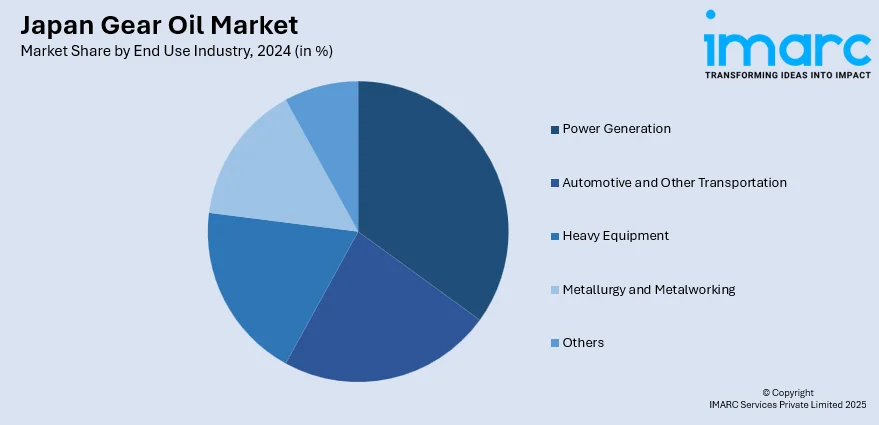
Japan Gear Oil Market Size, Share, Trends and Forecast by Product Type, End Use Industry, and Region, 2025-2033
Japan Gear Oil Market Overview:
The Japan gear oil market size reached 4,982.20 Million Litres in 2024. Looking forward, IMARC Group expects the market to reach 7,636.70 Million Litres by 2033, exhibiting a growth rate (CAGR) of 4.86% during 2025-2033. The market is driven by advancements in automotive and industrial machinery, fueling demand for high-performance gear oils that improve efficiency, durability, and thermal stability, particularly in EVs and hybrid systems. Stringent environmental regulations and shifting consumer preferences are accelerating the adoption of bio-based, sustainable lubricants with biodegradable formulations. Additionally, industrial automation and renewable energy sectors are further augmenting the Japan gear oil market share.
|
Report Attribute
|
Key Statistics
|
|---|---|
|
Base Year
|
2024 |
|
Forecast Years
|
2025-2033
|
|
Historical Years
|
2019-2024
|
| Market Size in 2024 | 4,982.20 Million Litres |
| Market Forecast in 2033 | 7,636.70 Million Litres |
| Market Growth Rate (2025-2033) | 4.86% |
Japan Gear Oil Market Trends:
Increasing Demand for High-Performance Gear Oils in Automotive and Industrial Sectors
The market is experiencing a rise in demand for high-performance lubricants, driven by advancements in automotive and industrial machinery. With Japan being a global leader in automotive manufacturing, there is a growing need for gear oils that enhance fuel efficiency, reduce wear, and extend equipment lifespan. For instance, Suzuki's global production reached 3.3 million units in 2024, representing a year-on-year growth of 2.3%. In particular, domestic production in Japan has risen by 10.3% to 1.03 million units. This growth in car production underscores the growing demand for high-performance parts, such as gear oils, necessary to enhance engine efficiency amid rising car production. The shift toward electric vehicles (EVs) and hybrid systems has also influenced gear oil formulations, requiring products with better thermal stability and compatibility with advanced drivetrain components. Additionally, industrial automation and heavy machinery sectors are adopting synthetic and semi-synthetic gear oils to improve operational efficiency under extreme conditions. Manufacturers are focusing on developing eco-friendly, low-viscosity gear oils that meet stringent environmental regulations while maintaining high performance. This trend is further supported by increasing investments in R&D to create innovative lubricant solutions tailored to Japan’s changing industrial and automotive needs.

Escalating Adoption of Bio-Based and Sustainable Gear Oils
The rising preference for bio-based and environmentally friendly lubricants is significantly supporting the Japan gear oil market growth. Stringent government regulations on carbon emissions and industrial waste are pushing manufacturers to develop gear oils derived from renewable sources, such as plant-based esters and biodegradable additives. Japan is working to reduce carbon emissions through ambitious policies aimed at achieving a 59% share of non-fossil fuel power generation by 2030, up from 31% in 2022. It will cut coal power from 31% to 19% and petroleum from 4% to 2%, increasing renewable energy, nuclear power, and cutting-edge technologies. These stringent emission standards will increase demand for high-performance gear oils, which are crucial to the efficiency of the changing energy industry. Companies are also focusing on reducing the environmental impact of lubricant disposal by introducing longer-lasting, recyclable formulations. The marine and wind energy sectors, in particular, are adopting sustainable gear oils to comply with international environmental standards. Furthermore, consumer awareness about eco-friendly products is influencing purchasing decisions, prompting lubricant brands to emphasize sustainability in their marketing strategies. As Japan continues to prioritize green initiatives, the demand for bio-based gear oils is expected to grow, creating opportunities for innovation and partnerships within the lubricant industry.
Japan Gear Oil Market Segmentation:
IMARC Group provides an analysis of the key trends in each segment of the market, along with forecasts at the country and regional levels for 2025-2033. Our report has categorized the market based on product type and end use industry.
Product Type Insights:
- Transportation
- Manual Gearbox
- Automatic Gearbox
- CVT
- DCT
- Axle Oils
- Industrial
The report has provided a detailed breakup and analysis of the market based on the product type. This includes transportation [manual gearbox, automatic gearbox (CVT and DCT), and axle oils] and industrial.
End Use Industry Insights:

- Power Generation
- Automotive and Other Transportation
- Heavy Equipment
- Metallurgy and Metalworking
- Others
A detailed breakup and analysis of the market based on the end use industry have also been provided in the report. This includes power generation, automotive and other transportation, heavy equipment, metallurgy and metalworking, and others.
Regional Insights:
- Kanto Region
- Kansai/Kinki Region
- Central/ Chubu Region
- Kyushu-Okinawa Region
- Tohoku Region
- Chugoku Region
- Hokkaido Region
- Shikoku Region
The report has also provided a comprehensive analysis of all the major regional markets, which include Kanto Region, Kansai/Kinki Region, Central/ Chubu Region, Kyushu-Okinawa Region, Tohoku Region, Chugoku Region, Hokkaido Region, and Shikoku Region.
Competitive Landscape:
The market research report has also provided a comprehensive analysis of the competitive landscape. Competitive analysis such as market structure, key player positioning, top winning strategies, competitive dashboard, and company evaluation quadrant has been covered in the report. Also, detailed profiles of all major companies have been provided.
Japan Gear Oil Market News:
- August 30, 2024: Idemitsu Kosan has introduced a new engine oil, IDEMITSU IFG Plantech Racing (0W-20), developed using over 80% plant-based raw materials and approved by API SP and Biomass Mark. To be launched in November 2024, this oil gives tremendous fuel efficiency, heat resistance, and wear resistance, thus optimizing engine performance for drivers. This new product strengthens Idemitsu's extensive global network, which includes a strong presence in the gear oil business.
- May 31, 2024: Eneos successfully produced re-refined base oil at its pilot plant using waste lubricants as part of a research project commissioned by the Japanese government into recycling in Japan. External testing has confirmed that gasoline engine oils made with this refined oil meet the high-temperature oxidation resistance test criteria (Sequence IH) on par with those made from virgin base oils. This development supports the Japanese gear oil industry by reducing CO2 emissions and promoting environmentally friendly production.
Japan Gear Oil Market Report Coverage:
| Report Features | Details |
|---|---|
| Base Year of the Analysis | 2024 |
| Historical Period | 2019-2024 |
| Forecast Period | 2025-2033 |
| Units | Million Litres |
| Scope of the Report |
Exploration of Historical Trends and Market Outlook, Industry Catalysts and Challenges, Segment-Wise Historical and Future Market Assessment:
|
| Product Types Covered |
|
| End-User Industries Covered | Power Generation, Automotive and Other Transportation, Heavy Equipment, Metallurgy and Metalworking, Others |
| Regions Covered | Kanto Region, Kansai/Kinki Region, Central/ Chubu Region, Kyushu-Okinawa Region, Tohoku Region, Chugoku Region, Hokkaido Region, Shikoku Region |
| Customization Scope | 10% Free Customization |
| Post-Sale Analyst Support | 10-12 Weeks |
| Delivery Format | PDF and Excel through Email (We can also provide the editable version of the report in PPT/Word format on special request) |
Key Questions Answered in This Report:
- How has the Japan gear oil market performed so far and how will it perform in the coming years?
- What is the breakup of the Japan gear oil market on the basis of product type?
- What is the breakup of the Japan gear oil market on the basis of end use industry?
- What is the breakup of the Japan gear oil market on the basis of region?
- What are the various stages in the value chain of the Japan gear oil market?
- What are the key driving factors and challenges in the Japan gear oil market?
- What is the structure of the Japan gear oil market and who are the key players?
- What is the degree of competition in the Japan gear oil market?
Key Benefits for Stakeholders:
- IMARC’s industry report offers a comprehensive quantitative analysis of various market segments, historical and current market trends, market forecasts, and dynamics of the Japan gear oil market from 2019-2033.
- The research report provides the latest information on the market drivers, challenges, and opportunities in the Japan gear oil market.
- Porter's five forces analysis assist stakeholders in assessing the impact of new entrants, competitive rivalry, supplier power, buyer power, and the threat of substitution. It helps stakeholders to analyze the level of competition within the Japan gear oil industry and its attractiveness.
- Competitive landscape allows stakeholders to understand their competitive environment and provides an insight into the current positions of key players in the market.
Need more help?
- Speak to our experienced analysts for insights on the current market scenarios.
- Include additional segments and countries to customize the report as per your requirement.
- Gain an unparalleled competitive advantage in your domain by understanding how to utilize the report and positively impacting your operations and revenue.
- For further assistance, please connect with our analysts.
 Request Customization
Request Customization
 Speak to an Analyst
Speak to an Analyst
 Request Brochure
Request Brochure
 Inquire Before Buying
Inquire Before Buying




.webp)




.webp)












